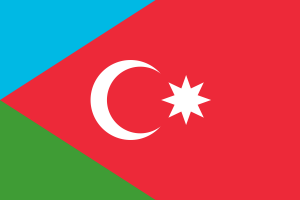Language/South-azerbaijani/Grammar/Adjectives
Hi South Azerbaijani learners! 😊
In this lesson, we will focus on adjectives in South Azerbaijani. Adjectives are an important part of any language, as they describe and modify nouns. You can use adjectives to describe the color, size, shape, or any other characteristic of a noun.
Consider exploring these related pages after completing this lesson: Give your Opinion, Plurals & Questions.
Adjectives Basics[edit | edit source]
In South Azerbaijani, adjectives are usually placed before the noun they modify. For example:
- Süniq sarı ud. (A beautiful yellow dress.)
In this sentence, we see that "süniq" (beautiful) comes before "sarı" (yellow), and both adjectives modify "ud" (dress).
There are also cases where adjectives can come after the noun they modify. However, this is less common in South Azerbaijani.
Adjective Agreement[edit | edit source]
In South Azerbaijani, adjectives must agree with the noun they modify in gender, number, and case.
Gender Agreement[edit | edit source]
South Azerbaijani nouns are either masculine or feminine. Adjectives must agree with the noun's gender. For example:
| South Azerbaijani | Pronunciation | English |
|---|---|---|
| bəyaz kitab | bayaz kitab | white book (masculine noun) |
| bəyaz çiçək | bayaz çichek | white flower (feminine noun) |
In the above example, we see that the adjective "bəyaz" (white) agrees with the gender of the noun. For masculine noun "kitab" (book), we use "bəyaz kitab", whereas for the feminine noun "çiçək" (flower), we use "bəyaz çiçək".
Number Agreement[edit | edit source]
South Azerbaijani nouns can be singular or plural. Adjectives must agree with the number of the noun. For example:
| South Azerbaijani | Pronunciation | English |
|---|---|---|
| qara paltar | qara paltar | black dress (singular noun) |
| qara paltar-lar | qara paltarlar | black dresses (plural noun) |
In this example, we see that the adjective "qara" (black) agrees with the number of the noun. For singular noun "paltar" (dress), we use "qara paltar", whereas for plural noun "paltar-lar" (dresses), we use "qara paltar-lar".
Case Agreement[edit | edit source]
South Azerbaijani has six cases: nominative, genitive, dative, accusative, locative, and ablative. Adjectives must agree with the case of the noun.
For example, if we want to say "I see a red car" in South Azerbaijani, we would say "Mən qırmızı maşın görürəm". In this sentence, "qırmızı" (red) agrees with the accusative case of "maşın".
Comparison of Adjectives[edit | edit source]
There are three degrees of comparison in South Azerbaijani: positive, comparative, and superlative.
The positive degree is used when we want to describe a single noun as it is. For example:
- Bura gözəl yerdir. (This is a beautiful place.)
The comparative degree is used when we want to compare two nouns. In South Azerbaijani, the comparative degree is formed by adding the suffix "-nisa" to the end of the adjective. For example:
- Bu paltar o-nisadan yaxşıdır. (This dress is better than that one.)
The superlative degree is used when we want to compare one noun with a group of nouns. In South Azerbaijani, the superlative degree is formed by adding the suffix "-nin ən" to the end of the adjective. For example:
- Mən Mərcanın ən gözəl vətəndaşıyam. (I am the most beautiful citizen of Mercan.)
The above sentence can also be written as "Mən Mercanda ən gözəl vətəndaşıyam" (I am the most beautiful citizen in Mercan).
Note that some adjectives have irregular forms for comparatives and superlatives. For example, "yaxşı" (good) has the comparative form "daha yaxşı" (better) and the superlative form "ən yaxşı" (best).
Dialogue[edit | edit source]
Here is a dialogue to help you see adjectives in context:
- Person 1: Bu davranış doğru deyil. (This behavior is not right.)
- Person 2: Sənin fikrinə görə, mən nə etməliyəm? (What should I do according to your opinion?)
- Person 1: O qədər sürətli gedir ki, qulaqdakı səsi eşitmirsən. (He/she is going so fast that you can't hear the sound in your ear.)
- Person 2: Həqiqətən də, səs çox kiçik idi. (Indeed, the sound was very small.)
In this dialogue, we see adjectives used to describe behavior, speed, and sound.
Conclusion[edit | edit source]
Adjectives are an important part of the South Azerbaijani language. To use them correctly, you must pay attention to gender, number, and case agreement. Don't be afraid to practice and make mistakes. To improve your South Azerbaijani Grammar, you can also use the Polyglot Club website. Find native speakers and ask them any questions!
➡ If you have any questions, please ask them in the comments section below.
➡ Feel free to edit this wiki page if you think it can be improved. 😎
Great work on completing this lesson! Take a moment to investigate these connected pages: Gender, Negation & Pronouns.

